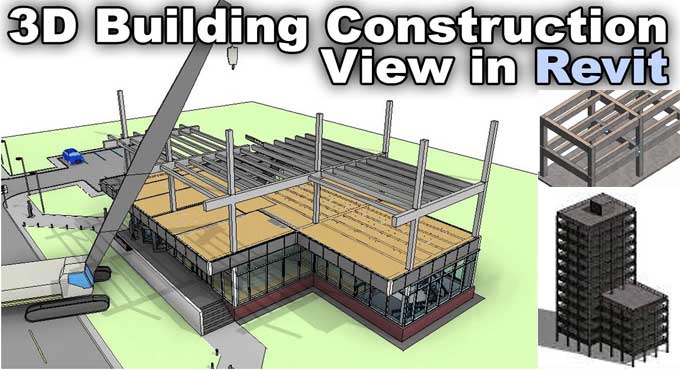A Guide to Using Revit in a Design and Construction Project
Tweet
AEC's design and construction processes have been streamlined with Building Information Modeling (BIM). Professionals can create intelligent 3D models using Autodesk Revit, leading BIM software. The capabilities of Revit redefine how AEC professionals coordinate projects and communicate, making it a new standard for efficiency and productivity.
In construction and design, Revit has unleashed the power of BIM, transforming collaboration, visualizing, analyzing, and optimizing projects. The collaborative design features promote effective communication and coordination among team members, reducing errors and improving project delivery. With the software's visualization and VR capabilities, stakeholders can communicate more effectively, while energy efficiency and sustainability can be optimized through performance analysis tools.
Collaborative Design
The foundation of Revit's revolutionary impact is its ability to support collaborative design. With Revit, architects, engineers, and contractors all collaborate on the same model simultaneously, preventing disagreements and minimizing mistakes that can result from older, fragmented workflows.
Real time collaboration is made possible by the program, allowing for seamless communication and information sharing amongst team members. Revit streamlines project delivery and lowers rework by combining the numerous disciplines into a single platform and fostering good communication and decision making.
Visualization and Virtual Reality
With the help of Revit, designers can brilliantly visualize their projects and improve client and stakeholder communication. Realistic renderings of the building's appearance and construction materials are possible because of the software's robust rendering and visualization tools.
Additionally, Revit supports the incorporation of virtual reality, offering immersive experiences that aid stakeholders in exploring and comprehending the design prior to construction. Virtual reality walkthroughs provide an unmatched opportunity to spot design problems, evaluate spatial relationships, and make wise decisions that ultimately improve project outcomes.
Performance Analysis and Optimization
Revit goes above and beyond conventional design software by allowing for performance optimization and analysis. The program includes tools for energy analysis, day lighting analysis, structural analysis, and other tasks. These tools enable designers to swiftly iterate, analyze multiple design possibilities, and make data driven judgments.
Professionals can optimize energy efficiency, occupant comfort, and sustainability, resulting in buildings that function better and use fewer resources. This is done by modeling and analyzing the performance of the building. Revit is an essential tool for producing high performing designs because of its connection with other analytical tools and its capacity to produce thorough reports.
Automation and Efficiency
Revit's automation tools dramatically increase productivity. Revit automates numerous tiresome activities by building an intelligent 3D model, including generating construction documentation, quantity takeoffs, and schedules. Professionals may concentrate on design and decision making since these automated procedures reduce errors, save time, and save resources.
The parametric modeling capabilities of Revit also allow for speedy design updates and revisions, ensuring that changes are automatically propagated throughout the project. This degree of automation decreases the possibility of inconsistencies between the design and construction phases and improves project coordination.
Clash Detection and Coordination
For spotting and resolving problems early in the design phase, Revit's collision detection and coordination skills are essential. Revit automatically checks for incompatibilities between elements by merging models from many disciplines, such as architectural, structural, and MEP (mechanical, electrical, and plumbing).
By doing this, costly rework and construction delays are avoided. Teams can visualize conflicts, communicate clearly, and work together to identify workable solutions with the coordination features in Revit, ensuring efficient project execution.
Parametric Design and Design Options
Architects and designers can easily explore multiple design options with Revit's parametric design capabilities. Design changes can be easily made and evaluated by defining relationships and constraints within the model.
Revit offers designers the ability to compare different versions of a design, evaluate their impact, and make informed decisions. As a result, flexible designs meet project requirements and satisfy client expectations by promoting innovation and creativity.
Construction Documentation and Information Management
Using Revit, construction documentation can be generated automatically, including floor plans, sections, elevations, and detail drawings. A Revit intelligent model ensures consistency across drawings by automatically reflecting changes made in one view. In addition to facilitating accurate quantity takeoffs and cost estimations, the software also enhances the control of project costs. It also facilitates effective information management and project communication, because Revit's data rich models serve as a central repository for project information.
To get online demonstration, watch the following video tutorial.
Video Source: Balkan Architect
Integration with Fabrication and Construction Processes
Construction workflows are improved by integrating Revit with fabrication and construction processes. Structure steel, precast concrete, and MEP components can be produced using the software. During fabrication and installation, this integration reduces errors and creates more efficiency, resulting in reduced construction costs. By integrating Revit with construction management software and field devices, the design and construction teams can collaborate in real time and increase productivity onsite.
Wrapping it Up
Collaboration, visualization, analysis, and optimization are not the only benefits Revit offers in the AEC industry. Its clash detection and coordination features minimize conflicts, while parametric design capabilities foster creativity and innovation. With streamlined construction documentation and information management, Revit improves project communication and control.
However, both software packages offer a wide range of features, so it is important to evaluate your specific needs before deciding which one is right for you. Ultimately, the best choice will depend on your unique requirements.

Gallery
Feel free to contact us for BIM requirements. One of our representative will respond you within 24 Hours. Send us your projects requirement today and grow your project.
Explore More !







